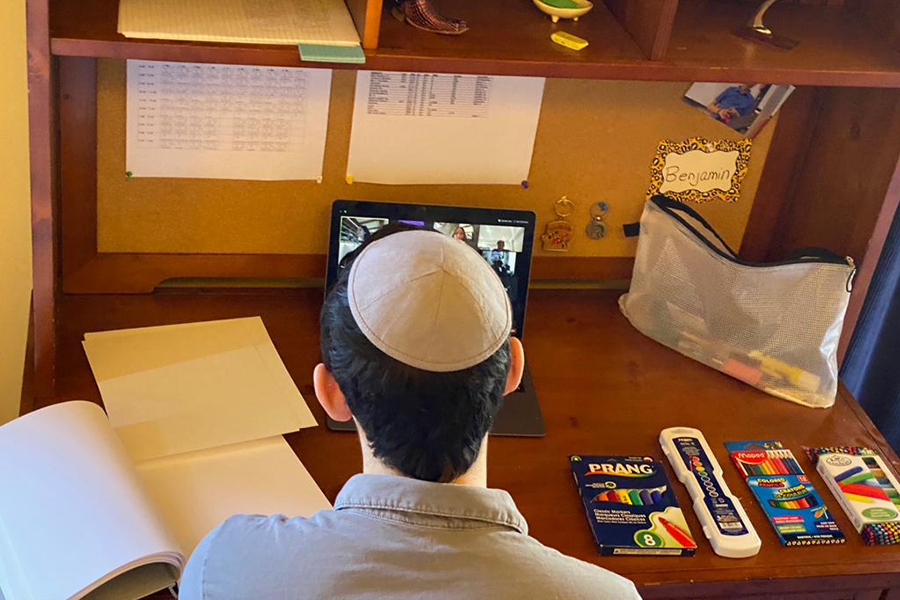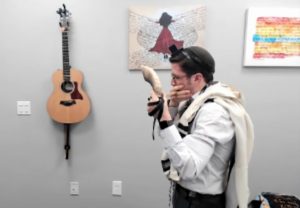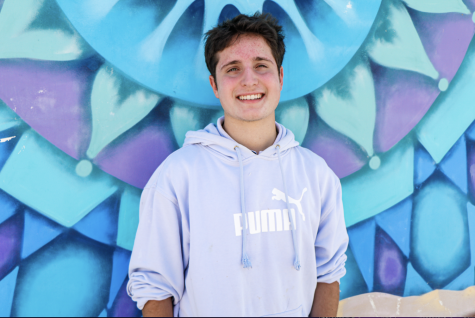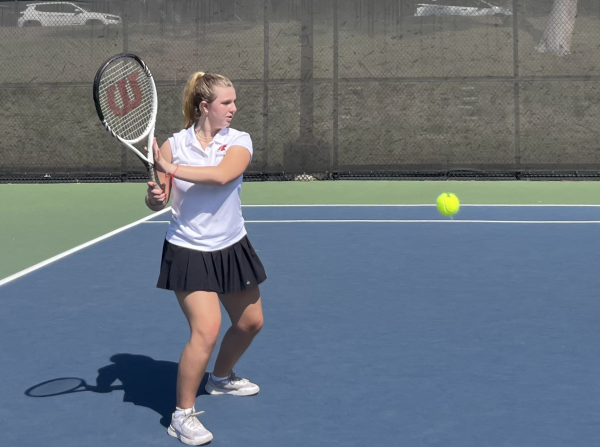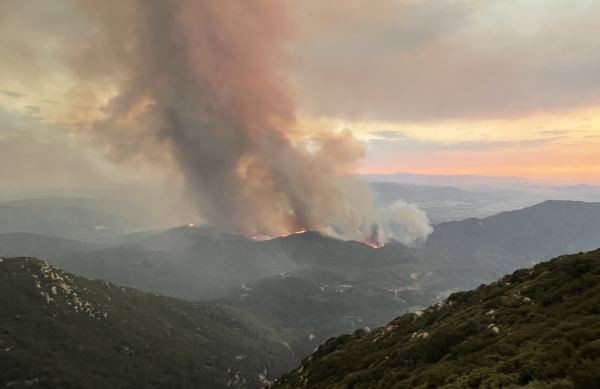Another first for Covid school: Art kits for everyone who’s taking art
SUPPLIES: Sophomore Benjamin Gamson attended art class on Zoom Sept. 22 with materials provided by the Art department. When in-person classes were cancelled in March, art supplies were at school and teachers had to find ways to teach without them.
September 25, 2020
When school started on Aug. 26, Shalhevet’s art students grabbed brand-new plastic mesh packages they’d picked up from school, opened their sketchbooks, and set themselves up for art class online.
Zoom screen and blank page in front of them, they would soon touch pen to paper and bring some beauty to the seemingly dark, Covid-infested world of 2020.
This year, Shalhevet’s art students were given basic supplies to use at home to create art together over Zoom. It’s a big improvement from last spring, teachers say, when the Visual Arts department was faced with a paper-and-paintbrush curriculum that suddenly had to migrate online.
“No one had art supplies [last year],” said art teacher Ms. Samantha Garelick in an interview. “No one had consistent art supplies — no one had even good paper to work with.”
For this year, Ms. Garelick and Art Department Chair Ms. Roen Salem asked school administration if the school could provide supplies in advance. The new art kits have equipped students with materials such as sketchbooks, charcoal pencils, and pastels for creating art at home.
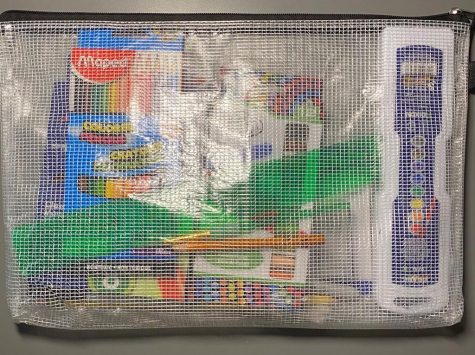
Even with the kits, students and teachers alike say art class this fall is a far cry from last fall, when unmasked students huddled around the Art Room tables and made art with friends and teachers, creating a collaborative space that has always been a treasured part of art classes at Shalhevet. Zoom has its problems, and even the closure of museums has hurt.
“We have a lot of fun in the art room — we tell jokes, we skip around the room, if someone has a birthday we might have a party — we do things that are a lot of fun,” said Ms. Salem.
“Say one day I hear about something at the museum. We could walk over to the art museum, or we could walk around the block and sketch a building, and we can talk about it and how it’s done and the perspective. But you can’t do that on Zoom.”
Ms. Garelick feels the same way, as do students.
“I absolutely love being in-person with my students,” Ms. Garelick said. “I love playing off of their energy, and having conversations with them in class, and having a real personal approach to the room. I am going to try my hardest to still allow us to have that collaborative environment.”
Sophomore Sam Graber is currently a student in Ms. Garelick’s virtual Composition and Design class and took her freshman Visual Art 101 elective last year.
“Last year, art class had a great environment,” said Sam. “We were able to relax, listen to music, and talk to our friends. This year we aren’t able to do those things.”
SAS Studio Art senior Noa Silberstein also misses the social aspect. This year, after learning as a group for two years or more, the juniors and seniors in SAS Art had to transition to making art in solitude, their friends boxed into a few pixels before their eyes.
“Doing art with your friends in the classroom is just fun,” said Noa. “You are in a better mood while you’re doing it, and it’s not as much as an assignment. It’s more just like I’m drawing while hanging out with friends.”
One problem that has been overcome from last year, however, is students’ lack of art supplies. When March came along and shut the school down, teachers had little to no time to allocate supplies for their students to use, let alone obtain and administer them.
Ms. Garelick was teaching a new curriculum in her 10th-grade Composition and Design class when Covid suddenly moved all of her classes onto Zoom.
“I just did my best to do any assignments I thought could work,” said Ms. Garelick. “[I] added a lot of new digital Zoom-based assignments that I came up with.”
This year, the art department in July received approval to purchase art supplies for individual students. Ms. Garelick ordered art kits from an art supply distributor.
The freshmen’s kits contained colored pencils, markers, oil pastels, watercolor, pencils, sharpies, scissors, rulers, blenders, glue sticks, pencil sharpeners, and a sketchbook. Sophomores were given two additional items: a pack of charcoal pencils and a larger sketchbook.
SAS Art students received art supplies in Ziploc bags assembled by Ms. Salem, containing supplies from around the art room. Ms. Salem explained that her students were given fewer supplies than Ms. Garelick’s students as they were more advanced and were expected to already have the basics at home.
Freshman Rami Melmed recalled going to Shalhevet before school started and receiving his own personal art pack. Reflecting on what he called “pandemic positives,” Rami said he enjoyed having art supplies with which to experiment at home.
Rami also said that although he looks forward to experiencing art in person with his friends, he thinks that learning at home might help him focus on learning art with less distractions.
Ms. Garelick said the personal kits are helping, but she also has been placing students into Zoom breakout rooms, using chat features, and encouraging her students to stay off of mute and contribute to achieve “a free flow of ideas.”
She also created assignments designed specially for online learning. For example, students in her freshman Visual Arts Class students were instructed to go outside and find textured surfaces in nature, then draw them onto the silhouette of an apple — creating a “textured apple.”
Ms. Garelick also plans a bring-your-pet-to-class day, a create-your-own-virtual-background day, and continuing a tradition of student DJs playing music in the background.
Ms. Salem is adding art history lessons into her curriculum and finding at-home art ideas like calligraphy collages. SAS students have particular skills they have to learn, such as drawing and shading objects, so Ms. Salem has students send pictures of their art to her via email and she comments on it virtually. In previous years, she would walk around the room and critique each student’s process while they were working.
Still, it’s not the same.
Senior Yael Rubin remembers fun times in the then-new art club during her freshman year with Ms. Salem and a few friends. That experience blossomed into a passion for art and camaraderie in the class which carried her to SAS Art junior and senior year, all with Ms. Salem.
Ms. Salem is now teaching optional Camp Firehawk sessions in the art room with masks and following social distancing precautions.
“It’s like old times,” she said. “I really enjoy it.”
She finds it challenging to navigate the Zoom platform, and recently purchased a new personal computer to make it easier, she said.
“For me,” she said, “it’s hard to hold supplies, hold the computer, move it around, pick the right environment, [and] not have my dog barking when the phone rings.”
Ms. Garelick has also struggled with Zoom — and like many teachers, has grown to understand that no matter how well they prepare, something can always go wrong.
“I taught three classes in a row the other day,” said Ms. Garelick. “I sat in the exact same spot, taught the exact same information, and had the exact same login and WiFi. Class one went flawlessly, class two I couldn’t get the video to play — the WiFi kept freezing — and then class three went perfectly again.”
While teachers and students are better equipped now to make art through Zoom, they are still not together in person.
“Art class was always a way to just connect with friends,” Ms. Garelick said. “We could work and talk and hang out and listen to music. So we’re still working and sort of hanging out and we’re definitely listening to music… but we’re not able to talk to each other in an organic way. I definitely miss that.”
Ms. Salem, who has been teaching art traditionally at Shalhevet for almost 29 years, is taking the long view.
“I don’t see a pro,” said Ms. Salem,. “I see the kids needing to be with each other, be in class, have a break in the day for art, they always say it’s the best time and they are so peaceful and they get a rest from all the activities.”
“It’s a challenge, I’ll tell you,” said Ms. Salem. “They are really sweet kids. I enjoy them. You know, I try to laugh it out. This too shall pass.”

